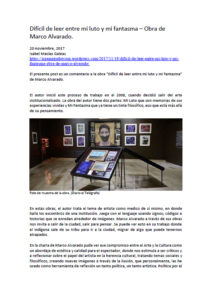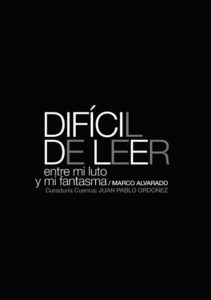Difícil de leer entre mi luto y mi Fantasma / Difficult to read: between my mourning and my ghost -2009-2016
El proyecto Difícil de leer: entre mi luto y mi fantasma se presentó por primera vez en la exposición ¿Es inútil sublevarse? La Artefactoría: Arte y comentario social en el Guayaquil de los ochenta (Guayaquil, Ecuador, 2016). En noviembre de 2017, fue llevada a Cuenca, al Museo de Las Conceptas, donde fue censurada por el Municipio a pedido de la Iglesia Católica. A partir de este suceso la Sala Proceso de la Casa de la Cultura de Cuenca, decidió acoger la exposición e inaugurarla en diciembre del mismo año. Actualmente está exhibido en La Artefactoría. Premio a la Trayectoria Artística Mariano Aguilera (Quito, 2019). El proyecto cuenta con una publicación homónima bajo el sello editorial de Editorial Festina Lente.
The project Difficult to read: between my mourning and my ghost was presented for the first time in the exhibition Is it useless to rise up? The Artefactoría: Art and social commentary in the Guayaquil of the eighties (Guayaquil, Ecuador 2016). In November 2017, the exhibition was taken to Cuenca, to the Museum of Las Conceptas, where it was censored by the Municipality at the request of the Catholic Church. From this event, the Process Room of the Casa de la Cultura of Cuenca, decided to host the exhibition and inaugurate it in December of the same year. It was currently exhibited at La Artefactoría. Mariano Aguilera Artistic Career Award (Quito, 2019). The project has a homonymous publication under the editorial seal of Editorial Festina Lente.
DESCARGA – Difícil de leer. Entre mi luto y mi fantastama
DOWNLOAD – Difficult to read. Between my mourning and my ghost (spanish)
DESCARGA Memorias de la Censura de Difícil de leer. Entre mi luto y mi fantastama
DOWNLOAD Memories of Censorship of Difficult to read. Between my mourning and my fantasy (spanish)
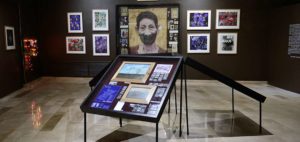
Difícil de leer: entre mi luto y mi fantasma inició en el 2009 cuando decidí emprender un viaje por diferentes partes del litoral ecuatoriano y me vinculé con algunas comunidades a través de actividades pedagógicas artísticas. El proyecto está compuesto por ocho urnas, que contienen la historia de este viaje. En ellas se puede ver mi paso por el recinto La Esperanza, al interior de la provincia de Guayas, y mi luto por el horror y la impotencia frente a los abusos del poder. Además de dieciséis imperativos, mensajes que me doy a mí mismo.
Difficult to read: between my mourning and my ghost began in 2009 when I decided to undertake a trip to different parts of the Ecuadorian coastline and connected with some communities through artistic pedagogical activities. The project is made up of eight urns, which contain the history of this trip. In them you can see my passage through the La Esperanza campus, in the interior of the Guayas province, and my mourning for the horror and impotence in the face of the abuses of power. In addition to sixteen imperatives, messages that I give myself.
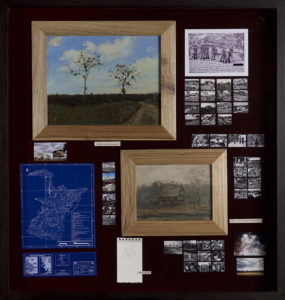
URNA: LA ESPERANZA / URN: THE HOPE
La Esperanza fue el nombre del proyecto de reforestación y agroforestería que el Estado implementó a través del Ministerio de Agricultura con varias agrupaciones de campesinos en torno al recinto del mismo nombre: La Esperanza. En el año 2008, el Ministerio y los campesinos aceptaron mi proyecto de vincularlos a un grupo de artistas e intelectuales para buscar modos de proteger el bosque seco a través del arte. Sin embargo, en el 2010 esas comunidades fueron víctimas de un desalojo en favor de los intereses personales de poderosos miembros de la red de corrupción que sostiene al Estado. En esta urna reúno imágenes de ese abusivo e ilegal desalojo y de la destrucción de las viviendas de La Esperanza, junto a un mapa técnico de inventario forestal y paisajes de la zona.
La Esperanza (The Hope) was the name of the reforestation and agroforestry project that the State implemented through the Ministry of Agriculture with various groups of farmers around the area of the same name: La Esperanza. In 2008, the Ministry and the peasants accepted my project of linking them to a group of artists and intellectuals to find ways to protect the dry forest through art. However, in 2010 these communities were victims of an eviction in favor of the personal interests of powerful members of the corruption network that supports the State. In this urn I gather images of this abusive and illegal eviction and the destruction of the houses in La Esperanza, together with a technical map of forest inventory and landscapes of the area.
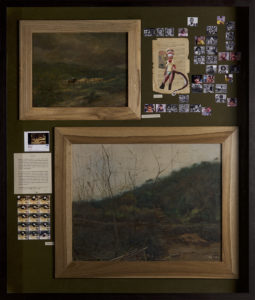
URNA: EL TINTÍN / URN: THE TINTÍN
Los niños de La Esperanza creen en el duende Tintín porque sus papás lo han visto. Existen lugares donde esta criatura fantástica siempre “se aparece”. Por lo general, es un sitio marcado por algún suceso extraño o que no se quiere nombrar. Hay hasta videos en Youtube que buscan probar su existencia.
En La Esperanza, los niños y las niñas trabajan, no suelen ir a la escuela. Fotografié a varios de ellos entre el 2009 y 2010. Habrán crecido ya. Sé que algunos de los niños son vendedores ambulantes ahora, mientras que otros trabajan como guardias de seguridad. En cuanto a las niñas, sé que algunas ya son mamás, y, como regularmente sucede, criarán solas a sus hijos. En esta urna reúno esas dos formas de inocencia: la una se sostiene en la superstición, la otra en el abandono y la ignorancia.
The children of La Esperanza believe in the elf Tintin because their parents have seen him. There are places where this fantastic creature always «appears». Generally, it is a site marked by some strange or unnamed event. There are even videos on YouTube that seek to prove their existence.
In La Esperanza, boys and girls work, they don’t usually go to school. I photographed several of them between 2009 and 2010. They will have grown up by now. I know that some of the children are street vendors now, while others work as security guards. As for the girls, I know that some are already moms, and, as is often the case, they will raise their children alone. In this urn I bring together these two forms of innocence: one is sustained by superstition, the other by abandonment and ignorance.
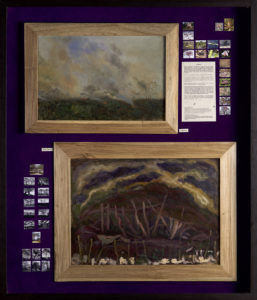
URNA: LA QUEMA / URN: THE BURNING
En esta urna dejo constancia de la destrucción del bosque seco, tal como lo vi yo. Quemar el monte es una actividad habitual y expansiva. Por lo general, se la realiza para sembrar maíz que resulta mejor en términos económicos. Las especies nativas y los bosques primarios se van perdiendo, al mismo tiempo que mueren los últimos vestigios de una cultura local que alguna vez habrá entendido su relación con la naturaleza de otra manera. Además, incluí un cuento que habla acerca de un curioso hombre citadino que anda perdido en el monte y que habla de una manera extraña. Esa es la manera en como mucha de la gente de La Esperanza me veía a mí.
In this urn I record the destruction of the dry forest, as I saw it. Burning the bush is a habitual and expansive activity. In general, it is done to plant corn that is better economically. Native species and primary forests are being lost, at the same time as the last vestiges of a local culture that will once have understood its relationship with nature in another way die. In addition, I included a story that talks about a curious city man who is lost in the mountains and who speaks in a strange way. That is the way many of the people of La Esperanza saw me.
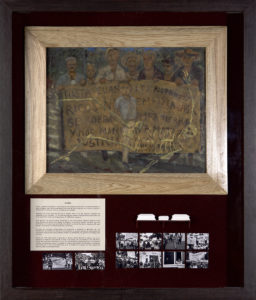
Esta obra contiene fotografías de la vez que nos tomamos el Malecón de Guayaquil, frente a las oficinas del INDA (Instituto Nacional de Desarrollo Agrícola). Reclamábamos el asesinato de doña María y su familia. El crimen lo cometió la famosa pandilla de “Los ocho”, conformada por policías, sicarios, mafiosos y chulos, con el único propósito de quitarles su predio. Los delincuentes fueron pescados robándose las balas del cadáver en la morgue pero la justicia, a la larga, no cayó sobre ellos, y, como de costumbre, no pasó nada, al igual que en cientos de casos similares.
This work contains photographs of the time we took the Malecón de Guayaquil, in front of the INDA (National Institute for Agricultural Development) offices. We claimed the murder of Miss Maria and her family. The crime was committed by the famous gang of «Los ocho», made up of policemen, hitmen, gangsters and pimps, with the sole purpose of taking away their property. The criminals were caught stealing the bullets from the corpse in the morgue but justice, in the long run, did not fall on them, and, as usual, nothing happened, as in hundreds of similar cases.
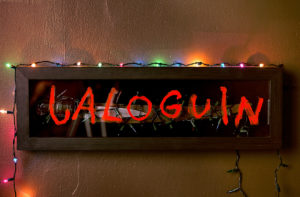
El metal se amarra al metal. El machete al puñal, como la maldad al despojo, a ritmo de poder patrio. Esta urna está dedicada a los jóvenes de La Esperanza que, hasta donde yo supe, no eran capaces de ubicar al Ecuador en un mapa, pero conocían el camino a los narcos y como fabricar armas caseras. ¡Felices fiestas!
Metal is tied to metal. From the machete to the dagger, like evil to plunder, at the rhythm of national power. This urn is dedicated to the young people of La Esperanza who, as far as I knew, were not capable of locating Ecuador on a map, but knew the way to the drug traffickers and how to make homemade weapons. Happy Holidays!
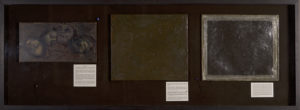
El título de esta urna se refiere a una especulación personal a partir del término fantasme utilizado por el psicoanalista francés Jacques Lacan. Pretendí meditar sobre mi trabajo reflexionando en lo que el mismo Lacan ha señalado como el sentimiento de impotencia filosófica y política que constantemente sublimamos a través de los lenguajes del arte. Y así fue, mediante la meditación, que mi obra se materializó gradualmente en fantasma; con lo cual no quiero decir que sea pura fantasía.
The title of this urn refers to a personal speculation based on the term phantom used by the French psychoanalyst Jacques Lacan. I tried to meditate on my work reflecting on what Lacan himself has pointed out as the feeling of philosophical and political impotence that we constantly sublimate through the languages of art. And so it was, through meditation, that my work gradually materialized into a ghost; which is not to say that it is pure fantasy.
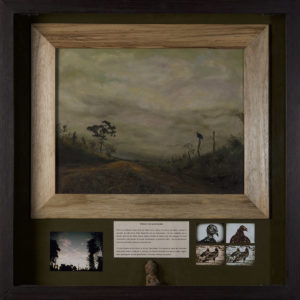
Aquí registré un evento singular: un campesino ebrio que narraba, sin saberlo, un encuentro cercano con un ser de otro mundo. ¿Era un plato volador o un inmenso gallinazo también llamado “guaraguao”?
Here I recorded a singular event: a drunken peasant narrating, without knowing it, a close encounter with a being from another world. Was it a flying saucer or an immense buzzard also called «guaraguao»?
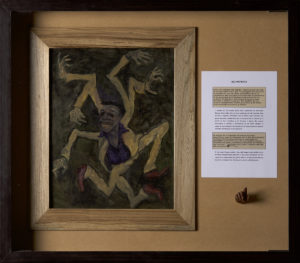
En esta urna registré más memorias relacionadas a ricos empresarios comprando comuneros para adueñarse de sus tierras. Sucesos que ocurren en el contexto de la desterritorialización indígena y campesina que se va generalizando en todas partes. Los comuneros corrompidos, por lo general, inician así una próspera carrera política.
In this urn I registered more memories related to rich businessmen buying community members to take over their lands. Events that occur in the context of indigenous and peasant deterritorialization that is becoming generalized everywhere. Corrupt comuneros, in general, thus begin a prosperous political career in this way.

Esta urna contiene reproducciones de obras que he realizado en diferentes momentos de mi trayectoria como artista. También hay fotografías de mis padres, del colectivo del cual formé parte en mi juventud, La Artefactoría, así como referencias a mi vida amorosa. Como telón de fondo se encuentra el retrato que pinté en 2006 de mi alter ego Catalino, un campesino que asusta al poder. En esta ocasión Catalino ofrece su manifiesto acerca de las “Mediaunidades psicográficas vinculadas al fenómeno intelectual”:
- Es posible conocer sin poseer sistema nervioso.
- Toda experiencia activa patrones cognitivos.
- Vivir es un proceso cognitivo.
- El conocimiento es un proceso biológico preexistente desde el campo ectopsíquico.
- Hacer arte tiende a expandirlo.
This urn contains reproductions of works that I have made at different times in my career as an artist. There are also photographs of my parents, of the group I was part of in my youth, La Artefactoría, as well as references to my love life. As a backdrop is the portrait I painted in 2006 of my alter ego Catalino, a peasant who scares power. On this occasion, Catalino offers his manifesto about «Psychographic Media Units linked to the intellectual phenomenon»:
1. It is possible to know without having a nervous system.
2. All experience activates cognitive patterns.
3. Living is a cognitive process.
4. Knowledge is a pre-existing biological process from the ectopsychic field.
5. Making art tends to expand it.
LOS IMPERATIVOS / THE IMPERATIVES
Difícil de leer son 16 palabras transformadas que develan fragmentos de mi historia personal. En un color están imperativos categóricos, que como palabra-objeto, en un proceso de imaginación suspendida, me permití abrir para complementarlas con voces indígenas. Estas se pueden observar en otro color. Las fotos del fondo son el registro de un largo viaje de búsquedas personales.
Difficult to read are 16 transformed words that reveal fragments of my personal history. In one color there are categorical imperatives, which as word-object, in a process of suspended imagination, I allowed myself to open up to complement them with indigenous voices. These can be seen in another color. The photos in the background are the record of a long journey of personal searches.
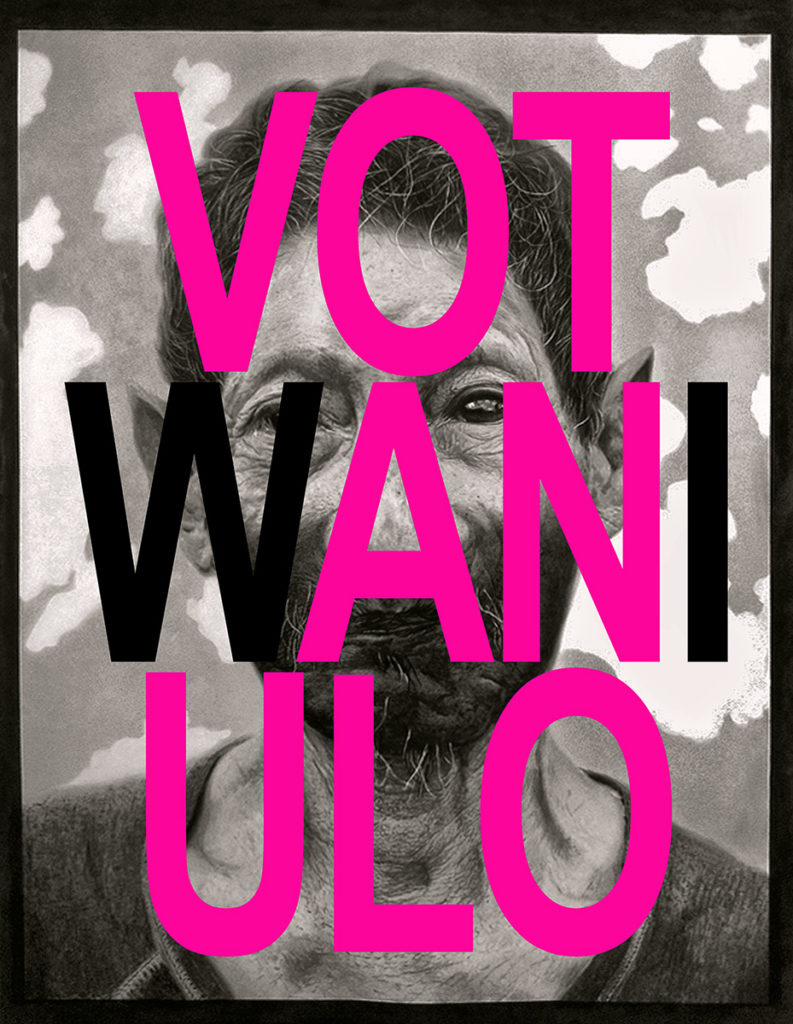
VOTWANIULO
Vota nulo + Wi (yo, en lengua shuar)
Impresión Glicée sobre papel. 52,7 x 40,8 cms.
Fotografía de fondo: Catalino. Óleo sobre tela.
Pienso que el voto nulo es la opción democrática a nuestra disposición para anular procesos electorales forzados y a políticos incapaces. Votar nulo en masa serviría para hacer sentir nuestra inconformidad y disidencia. Pero el mismo sistema que te permite anular un voto que, de por sí, es obligatorio, le quita todo efecto a esa acción. La democracia es sólo un psicodrama social, perceptible en el rechazo generalizado a la clase política. El voto nulo debería ser una herramienta para reflexionar y debatir públicamente sobre otras opciones para organizar nuestras vidas.
Vote null + Wi (I, in the Shuar language)
Glicée print on paper. 52.7 x 40.8 cms.
Background photography: Catalino. Oil on canvas.
I think that the null vote is the democratic option at our disposal to annul forced electoral processes and incapable politicians. Voting null and void en masse would serve to make our dissatisfaction and dissent felt. But the same system that allows you to cancel a vote that, in itself, is mandatory, removes all effect from that action. Democracy is just a social psychodrama, perceptible in the general rejection of the political class. The invalid vote should be a tool to reflect and publicly debate about other options to organize our lives.
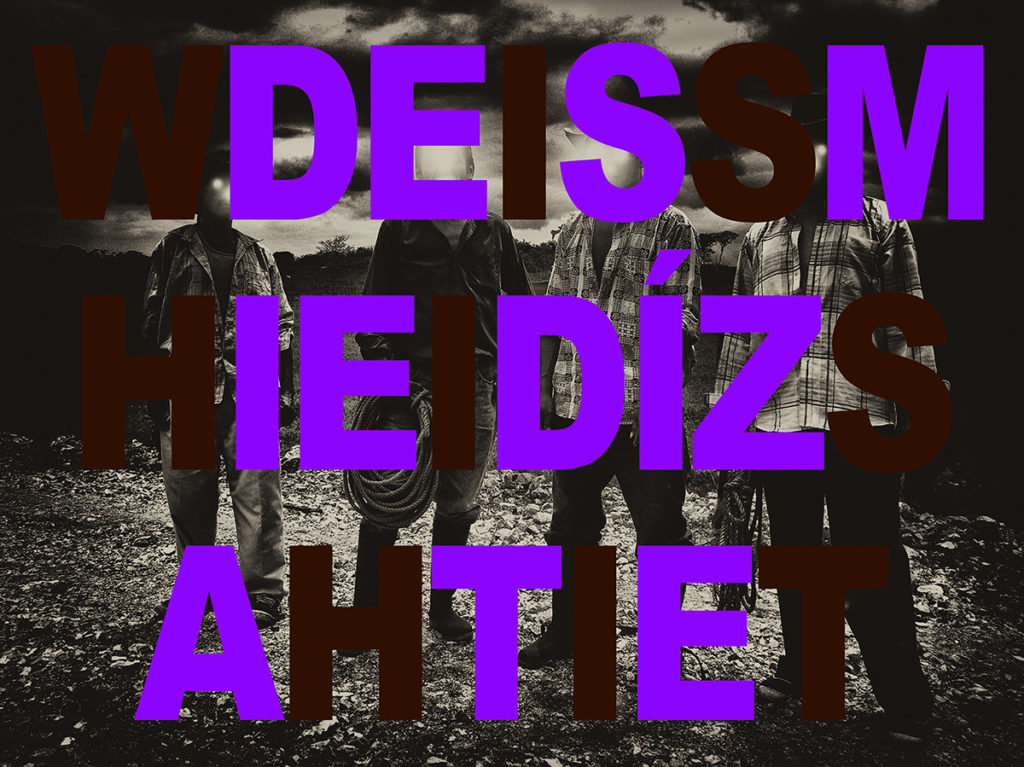
WDEISSMHIEIDÍZSAHTIET
Desmiedízate (de miedo) + Wishishit (sonrisa en lenguaje shuar). Impresión Glicée sobre papel. 54 x 60,3 cms. Edición de 10 + 2 PA.
Buscando explicaciones biológicas para lo estético, encontré unas investigaciones que aseguraban que nuestro sistema límbico contiene claves para comprender muchos de los patrones conductuales y culturales que nos marcan como nación. Así que tenemos las herramientas, biológicamente hablando, para echar una mirada crítica sobre nuestra sociedad. Indudablemente, algo digno de atención es cómo el miedo es utilizado como un instrumento del poder. El miedo nos condiciona, nos inmoviliza y nos divide y de él se nutren los tiranos. Actualmente está sucediendo, con dictaduras disfrazadas de gobiernos democráticos, impecablemente populistas y con niveles de corrupción nunca antes alcanzados, que están logrando implementar sistemáticamente la coerción a todo nivel para perpetuarse en el poder. Verlo es vital.
Fearless (scared) + Wishishit (smile in Shuar language). Glicée print on paper. 54 x 60.3 cms. Edition of 10 + 2 PA.
Looking for biological explanations for aesthetics, I found research that claimed that our limbic system contains keys to understanding many of the behavioral and cultural patterns that mark us as a nation. So we have the tools, biologically speaking, to take a critical look at our society. Undoubtedly, something worthy of attention is how fear is used as an instrument of power. Fear conditions us, immobilizes us, and divides us, and tyrants feed on it. Currently it is happening, with dictatorships disguised as democratic governments, impeccably populist and with levels of corruption never before reached, which are managing to systematically implement coercion at all levels to perpetuate themselves in power. Seeing it is vital.
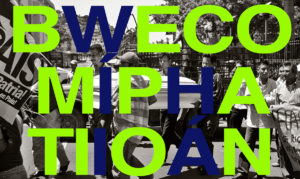
BWECOMÍPHATHIOAN
Be compation (“be compassionate”) + Wíhiá (corazón en idioma záparo)
Impresión Glicée sobre papel. 37,8 x 63,5 cms.
Fotografía de fondo: Campesinos indignados que cerraron el malecón de Guayaquil frente al INDA, portando féretros de una familia asesinada por sicarios de tierras. Protestaban por la negligencia de las autoridades frente a la problemática de tierras en el litoral ecuatoriano.
Esta obra hace referencia a una anecdótica respuesta que el Dalai Lama ofreció durante un conversatorio en la Universidad de Colorado (EEUU) en el verano de 1997 a quienes le preguntaban sobre la corrupción e indolencia de los gobernantes populistas. La he deformado de manera casi imperceptible, en inglés mal escrito y mal pronunciado, tan fatuo y falso como son los discursos del poder. Cito este discurso junto a otra palabra, en azul. Ésta viene de una voz indígena que habla en la lengua prácticamente extinta de un pueblo semi-desconocido: los Záparo.
Be compation (“be compassionate”) + Wíhiá (heart in Záparo language)
Glicée print on paper. 37.8 x 63.5 cms.
Background photo: Indignant peasants who closed the Guayaquil boardwalk in front of the INDA, carrying coffins of a family killed by land hitmen. They were protesting the negligence of the authorities in the face of the land problem on the Ecuadorian coast.
This work refers to an anecdotal response that the Dalai Lama offered during a discussion at the University of Colorado (USA) in the summer of 1997 to those who asked him about the corruption and indolence of the populist rulers. I have distorted it in an almost imperceptible way, in badly written and badly pronounced English, as fatuous and false as the speeches of power are. I quote this speech along with another word, in blue. This comes from an indigenous voice that speaks in the practically extinct language of a semi-unknown people: the Záparo.
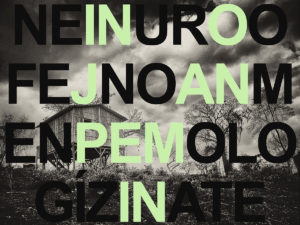
NEINUROOFEJNOANMENPEMOLOGÍZINATE
Neurofenomenologízate + Ino Janpemin (hacerse shamán en lengua tsáfiqui)
Impresión Glicée sobre papel. 38,7 x 51,6 cms.
Fotografía de fondo: Mi casa en el recinto La Esperanza.
Neurofenomenología es el nombre de un programa de investigación científica propuesto por el biólogo Francisco Varela (Chile 1946-Francia 2001) que combina la neurociencia, o estudio del sistema nervioso, con la fenomenología, o estudio de la conciencia y sus procesos. Una pregunta que sale de este campo sería: ¿puede el arte dialogar con la problemática de la conciencia y expandirla hacia afuera del paradigma funcionalista?
Neurophenomenologize yourself + Ino Janpemin (become a shaman in the Tsáfiqui language)
Glicée print on paper. 38.7 x 51.6 cms.
Background photography: My house in the La Esperanza compound.
Neurophenomenology is the name of a scientific research program proposed by the biologist Francisco Varela (Chile 1946-France 2001) that combines neuroscience, or the study of the nervous system, with phenomenology, or the study of consciousness and its processes. A question that comes out of this field would be: can art dialogue with the problem of consciousness and expand it outside the functionalist paradigm?

ÉELPPUEEBRLONAOEXAISTRAE
El pueblo no existe + Éperaara (ser humano o persona en lengua sia pedee)
Impresión Glicée sobre papel. 52,8 x 39,6 cms.
Fotografía de fondo: Abel es un guerrero shuar excombatiente de la guerra con el Perú. También es padre de diez hijos, como lo fue su padre antes que él y el padre de su padre; todos ancestralmente alimentados por la selva. Pero ahora ya no queda selva, dice Abel, porque se la acabaron los madereros y las petroleras. Ahora que mi hija mayor debe ir a la universidad, tengo que salir a la ciudad a buscar trabajo para pagarle un cuarto. Deberé trabajar en la construcción y convertirme en un ‘indio de mierda’ más.
Lo indígena es una manera de estar en el mundo, independientemente de la raza o nacionalidad. “Indígena” es un término colectivo que nombra a quienes han sabido preservar sus hábitats naturales por siglos. Términos como “pueblo” y “progreso”, en cambio, son vacíos y altamente populistas.
Los indígenas aprenden desde pequeños a reconocer la naturaleza como su familia. Esto es algo que a la mente urbana le resulta incomprensible, porque aprendimos que la naturaleza es una propiedad. Por eso no se tiene escrúpulos al momento de arrasarla. Pero todavía hay quienes pensamos que es posible crear una economía de objetivos en vez de una economía de precios y que aún podemos reconocer a parientes entre los seres vivos del planeta.
The town does not exist + Éperaara (human being or person in the Sia Pedee language)
Glicée print on paper. 52.8 x 39.6 cms.
Background photo: Abel is a former Shuar warrior from the war with Peru. He is also the father of ten children, as was his father before him and the father of his father; all ancestrally fed by the jungle. But now there is no more forest, says Abel, because the loggers and oil companies have finished it. Now that my oldest daughter has to go to college, I have to go to the city to find work to pay for a room. I’ll have to work in construction and become one more ‘shitty Indian’.
The indigenous is a way of being in the world, regardless of race or nationality. «Indigenous» is a collective term that names those who have known how to preserve their natural habitats for centuries. Terms like «people» and «progress», on the other hand, are empty and highly populist.
Indigenous people learn from a young age to recognize nature as their family. This is something that the urban mind finds incomprehensible, because we learned that nature is property. That is why you have no scruples when it comes to razing it. But there are still those of us who think that it is possible to create an economy of objectives instead of an economy of prices and that we can still recognize relatives among the living beings of the planet.
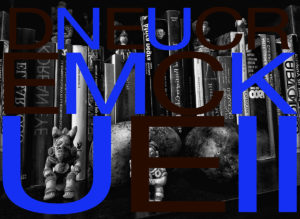
DNEUCREMCKUEI
Decrece + Numkuii (nombre de la diosa de la fertilidad en idioma shuar)
Impresión Glicée sobre papel. 43 x 58,9 cms.
Fotografía de fondo: Mi biblioteca.
El decrecimiento de la población es una alternativa viable para los muchos problemas generados por la sobrexplotación de nuestro planeta, una solución que, tarde o temprano, tendremos que aplicar. Decrecer en este sentido significa dejar de creer en el progreso sustentado en el crecimiento y el consumo, significa apartarnos del modelo monetarista que considera el dinero como un fin, para ir hacia un nuevo modelo que lo utilice como un medio. Mientras más tardemos en aceptarlo, más doloroso será.
La voz indígena en este Imperativo llama a Numkuii, una diosa de la fertilidad, porque, a futuro, decrecer puede significar abundancia para todos.
Decrece + Numkuii (name of the goddess of fertility in the Shuar language)
Glicée print on paper. 43 x 58.9 cms.
Background photography: My library.
The decrease in population is a viable alternative to the many problems generated by the over-exploitation of our planet, a solution that, sooner or later, we will have to apply. To decrease in this sense means to stop believing in the progress supported by growth and consumption, it means to move away from the monetarist model that considers money as an end, to move towards a new model that uses it as a means. The longer we take to accept it, the more painful it will be.
The indigenous voice in this Imperative calls Numkuii, a goddess of fertility, because, in the future, decrease can mean abundance for everyone.
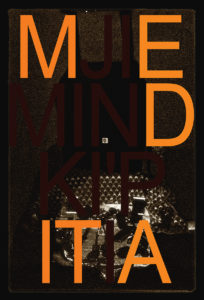
MJIEMINDI’PITIA
Medita + Jimin Ki’pi (el que sabe ir al sueño en lengua tsáfiqui)
Impresión Glicée sobre papel. 57,5 x 39 cms.
Fotografía de fondo: Silla de muerto. Obra realizada en los años 80 con objetos encontrados en distintos cementerios y coronas fúnebres escenificadas en torno a una silla vacía. Esta obra se quemó en el incendio del Museo del Banco del Pacífico de Guayaquil en 1985, durante la exposición Arte Popular Religioso del Ecuador.
Esta obra ilustra la fascinación por la muerte tan presente en la cultura popular como en la historia del arte. Aquello que intuimos que se encuentra del otro lado nos atrae. Puede ser porque vislumbramos la posibilidad de cruzar ese umbral. Quizás sea porque siempre hemos sabido que es posible ir hacia aquello que desconocemos pero que nos han enseñado a negar y a temer. Quizás se pueda ir a lo que es diferente, al otro lado del sueño, al más allá de la seguridad, incluso al más allá del lenguaje.
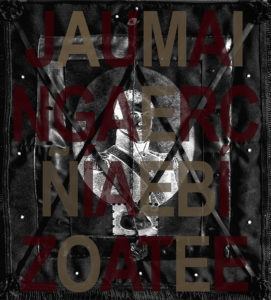
JAUMAINGAERCÑÍAEBÍZOATEE
Juangarcíaízate + Ami eñeboe (enséñame en lengua wao)
Impresión Glicée sobre papel. 44 x 39,7 cms.
Fotografía de fondo: Vudú para Bolívar.
Esta obra expresa mi admiración y respeto personal por la figura de Juan García Salazar y tiene como propósito rendirle homenaje. Juan es esmeraldeño, hijo de madre negra y padre español. Se destacó siempre por su carácter rebelde. Nunca toleró la escuela como institución, aunque sí amaba estudiar e investigar. Por ello, Juan se convirtió en un carpintero ilustrado. Durante 25 años se dedicó a estudiar y recuperar la historia invisibilizada de los habitantes de su provincia, amasando una importante cantidad de registros e información que luego decidió donar a la Universidad Andina de Quito para crear el fondo Afroandino. A la luz de este trabajo, la Universidad Johns Hopkins de los Estados Unidos le ofreció una beca para obtener una maestría en historia. Ahora, Juan, “el bambero” mayor, es historiador en ejercicio activo y docente. Se dedica a enseñar con el modelo etnoeducativo que él mismo diseñó para desaprender y subvertir lo impuesto.
Juangarcíaízate + Ami eñeboe (teach me in the Wao language)
Glicée print on paper. 44 x 39.7 cms.
Background photography: Voodoo for Bolívar.
This work expresses my admiration and personal respect for the figure of Juan García Salazar and its purpose is to pay tribute to him. Juan is from Esmeralda, the son of a black mother and a Spanish father. He was always noted for his rebellious character. He never tolerated school as an institution, although he did love to study and research. Therefore, Juan became an enlightened carpenter. For 25 years he dedicated himself to studying and recovering the invisible history of the inhabitants of his province, amassing an important amount of records and information that he later decided to donate to the Andean University of Quito to create the Afro-Andean fund. In light of this work, Johns Hopkins University in the United States offered him a scholarship to obtain a master’s degree in history. Now, Juan, «el bambero», is an active historian and teacher. He is dedicated to teaching with the ethno-educational model that he himself designed to unlearn and subvert what is imposed.
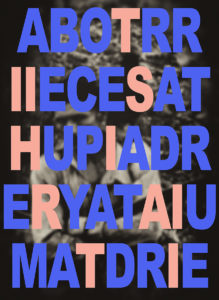
ABOTRRIIECESATHUPIADRERYATAIUMATDRIE
Aborrece a tu padre y a tu madre + Wat kintai TISHIRAITI (amaneció bonito o buenos días en lengua awá pit) Tiishiraiti (felicidades en idioma shuar)
Impresión Glicée sobre papel. 52,8 x 38,5 cms.
Fotografía de fondo: Un cazador ermitaño en el recinto La Esperanza.
Si alguno viene a mí, y no aborrece a su padre y madre, a su mujer e hijos, a sus hermanos y hermanas, y aun hasta su propia vida, no puede ser mi discípulo.
(Lucas 14:26)
Carl Gustav Jung planteó el principio de individuación como el proceso que generaría a un individuo psicológicamente independiente, despojado de los condicionamientos culturales transmitidos por la familia. El principio de Jung cita el mandato bíblico contenido en este imperativo, identificando y desechando lo omnipresente transmitido desde el lenguaje por las figuras paterna y materna. Lo complejo, sin embargo, es transformar este pensamiento en acción.
Hate your father and mother + Wat kintai TISHIRAITI (beautiful morning or good morning in Awá Pit language) Tiishiraiti (congratulations in Shuar language)
Glicée print on paper. 52.8 x 38.5 cms.
Background photography: A hermit hunter in the La Esperanza enclosure.
If anyone comes to me and does not hate his father and mother, his wife and children, his brothers and sisters, and even his own life, he cannot be my disciple.
(Luke 14:26)
Carl Gustav Jung raised the principle of individuation as the process that would generate a psychologically independent individual, stripped of the cultural conditioning transmitted by the family. Jung’s principle cites the biblical mandate contained in this imperative, identifying and discarding the omnipresent transmitted from the language by the father and mother figures. The complex thing, however, is to transform this thought into action.
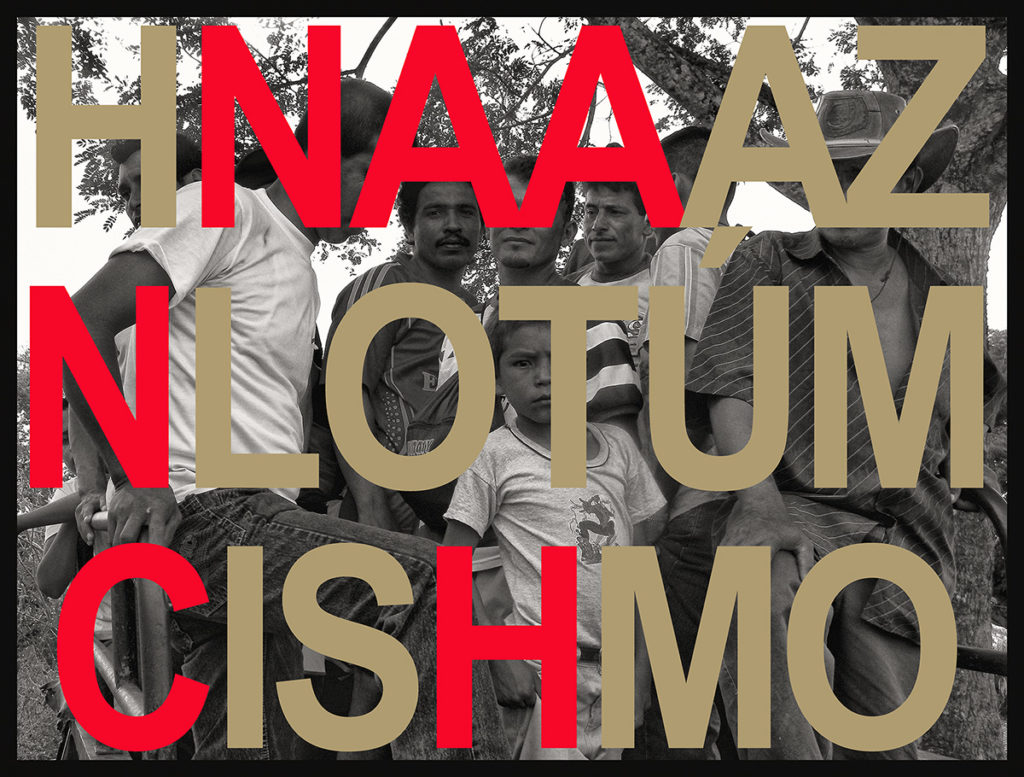
HNAAAZNLOTÚMCISHMO
Hazlo tú mismo + Naanch (guerrero en idioma shuar)
Impresión Glicée sobre papel. 43 x 56,7 cms.
Fotografía de fondo: Campesinos del recinto La Esperanza saliendo al poblado.
Desde la época de la colonia española aprendimos que nuestro destino no nos pertenece, sino que depende siempre de agentes externos legitimadores. El adoctrinamiento católico funcionó en esta clave. La autoridad jerárquica, la culpa y la responsabilidad del fracaso, fueron siempre del otro o de la voluntad divina. Aprendimos que debíamos aceptar resignadamente este destino. Las perversas manipulaciones religiosas del poder cambiaron la espiritualidad sana en supersticiosa, taimada y castrada codicia. Aquí radica una de las diferencias culturales esenciales que nos separa de los habitantes del norte.
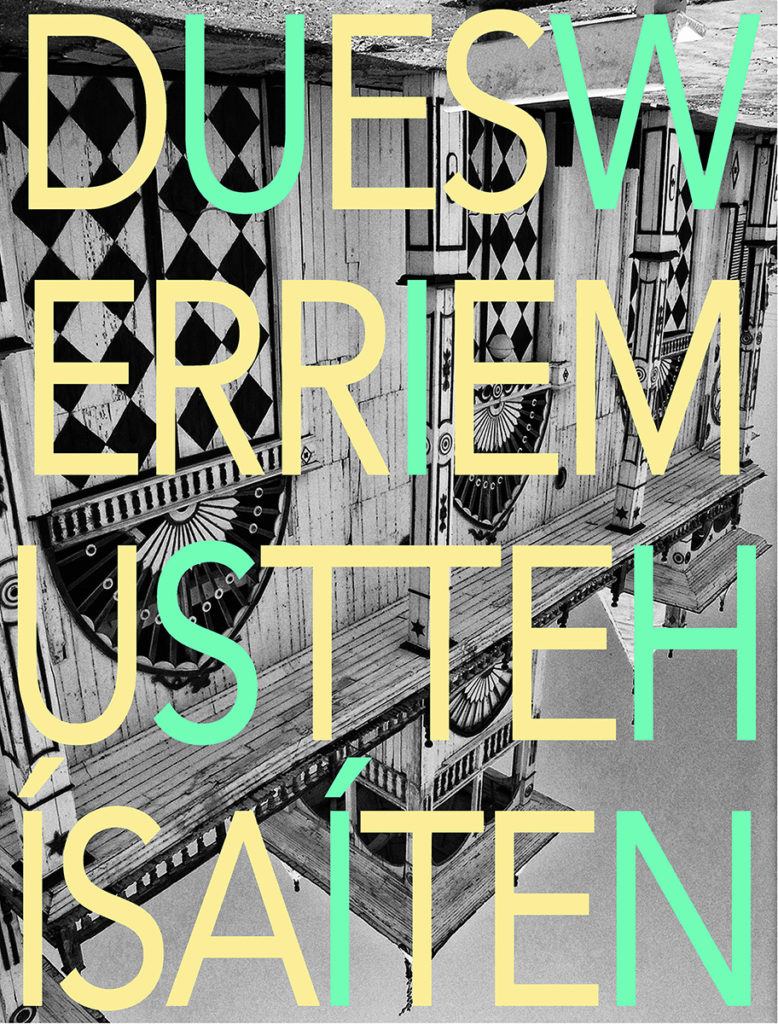
DUESWERRIEMUSTTEHÍSAÍTEN
Deserremutteísate + Uwishin (shamán en idioma shuar)
Impresión Glicée sobre papel. 54,6 x 41,5 cms.
Fotografía de fondo: Iglesia de El Morro invertida, provincia del Guayas.
El neologismo Deserremutteísate hace referencia a R. Mutt, la firma en el urinario ready made de Marcel Duchamp. Esta obra, por lo tanto, alude a la tradición conceptual que se pregunta por la institucionalidad artística y especula si habremos llegado a un momento en que el arte se convirtió en una suerte de fe entre quienes la pregonan y deciden creer en ella. No podemos definir qué es arte de manera objetual, entonces pasamos al mundo de las ideas. Hay arte porque creemos que existe. ¿Podemos huir de la obra artística, y compartirla, sin elevar altares? Esto supondría trabajar al margen del sistema capitalista en todas sus versiones contemporáneas, incluso las más revolucionarias. ¿Pero qué supone trabajar al margen?
Deserremutteísate + Uwishin (shaman in Shuar language)
Glicée print on paper. 54.6 x 41.5 cms.
Background photography: Inverted El Morro Church, Guayas province.
The neologism Deserremutteísate refers to R. Mutt, the signature on Marcel Duchamp’s ready-made urinal. This work, therefore, alludes to the conceptual tradition that asks about the artistic institutionality and speculates whether we have reached a moment when art became a kind of faith among those who proclaim it and decide to believe in it. We cannot define what art is objectively, so we move on to the world of ideas. There is art because we believe it exists. Can we flee from the artistic work, and share it, without raising altars? This would mean working outside the capitalist system in all its contemporary versions, even the most revolutionary ones. But what does it mean to work on the sidelines?
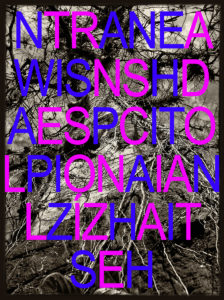
NTRANEAWISNSHDAESPCITOLPIONAIANLZÍZHAITSEH
Transdescolonízate + Nane wishãpit pianzhish (yo no sé hablar la lengua de los mestizos, en lengua awá pit, del pueblo awa)
Impresión Glicée sobre papel. 58 x 43,4 cms.
Fotografía de fondo: Tronco de un anciano árbol en las montañas del recinto La Esperanza.
Paradójicamente, el término descolonizar está en peligro de volverse una palabra más que está de moda, carente de autenticidad. La descolonización debe ser una tarea de todos y debería empezar por transparentar la decadencia de las instituciones que sostienen al Estado. Sin embargo, aun nuestros más destacados intelectuales han fracasado en sus intentos, a la hora de la hora.
Nane wishãpit pianzhish: difícil tarea, amigo Sancho, ha sido esto de la descolonización.
Deserremutteísate + Uwishin (shaman in Shuar language)
Glicée print on paper. 54.6 x 41.5 cms.
Background photography: Inverted El Morro Church, Guayas province.
The neologism Deserremutteísate refers to R. Mutt, the signature on Marcel Duchamp’s ready-made urinal. This work, therefore, alludes to the conceptual tradition that asks about the artistic institutionality and speculates whether we have reached a moment when art became a kind of faith among those who proclaim it and decide to believe in it. We cannot define what art is objectively, so we move on to the world of ideas. There is art because we believe it exists. Can we flee from the artistic work, and share it, without raising altars? This would mean working outside the capitalist system in all its contemporary versions, even the most revolutionary ones. But what does it mean to work on the sidelines?

BIOARRMEIGWIAONAKLEÍRZAAGTE
Biorregionalízate + Ami wakerag (te quiero en idioma shuar)
Impresión Glicée sobre papel. 38,7 x 56 cms.
Fotografía de fondo: Una quema en predios del cantón Pedro Carbo, Provincia del Guayas.
Es posible que una nueva era planetaria en la que el modelo Estado-Nación llegue a una decadencia total esté más cerca de lo que suponemos. Este modelo fracasado podría ser suplantado por modelos de organización y administración biorregionales. Actualmente la preocupación por nuestra supervivencia en el planeta está generalizada, excepto en la clase política y los sectores sociales alienados. Es momento de que apoyemos e impulsemos la opción biorregionalista con proyectos bio-éticos. Enfoquémonos en administrar nuestros hábitats de manera sostenible. Apoyemos estas opciones pacifistas ante la amenaza del exterminio.
Bioregionalízate + Ami wakerag (I love you in Shuar language)
Glicée print on paper. 38.7 x 56 cms.
Background photography: A burning on land in the Pedro Carbo canton, Guayas Province.
It is possible that a new planetary era in which the Nation-State model reaches a total decline is closer than we assume. This failed model could be supplanted by bioregional organization and administration models. Currently the concern for our survival on the planet is widespread, except in the political class and alienated social sectors. It is time for us to support and promote the bioregional option with bio-ethical projects. Let’s focus on managing our habitats sustainably. Let us support these pacifist options in the face of the threat of extermination.
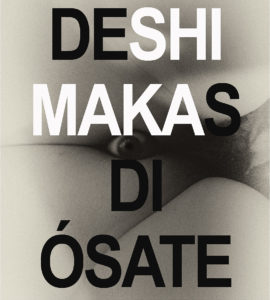
DESHIMAKASDIÓSATE
Desdiósate + Shimaka (sabiduría en idioma záparo)
Impresión Glicée sobre papel. 50 x 45cms.
Fotografía de fondo: El ojo de Dios.
Esta obra cita la fuerza de mis pulsiones eróticas, al mismo tiempo que hace referencia a mis frustradas aspiraciones de liberación sexual. En cierta ocasión, cuando exploraba en mi mente con la intención de identificar las sublimaciones que había hecho de mis pulsiones, me vi a mí mismo de adolescente visitando París. Allí contemplé la pintura de Gustave Courbet, “El origen del mundo”, y, en mi imaginación, le di la vuelta al cuadro. Para mi sorpresa, fue entonces cuando vi el ojo omnipresente y justiciero del Dios eterno, que otra vez clavaba su mirada en mis deseos.
Goodbye + Shimaka (wisdom in zaparo language)
Glicée print on paper. 50 x 45cms.
Background photography: The eye of God.
This work cites the strength of my erotic drives, at the same time that it refers to my frustrated aspirations for sexual liberation. On one occasion, when I was exploring my mind with the intention of identifying the sublimations that I had made of my drives, I saw myself as a teenager visiting Paris. There I looked at Gustave Courbet’s painting «The Origin of the World» and, in my imagination, I turned the painting upside down. To my surprise, it was then that I saw the omnipresent and righteous eye of the eternal God, which once again stared at my desires.

DTEIISLSATINHOAMERRICANÍAZIATTEI
Deslatinoamericanízate + Tiishiraiti (felicidades en idioma shuar). 2016 Impresión Glicée sobre papel. 44,2 x 58,4 cm. Edición de 10 + 2 PA.
Esta obra emplea el término Latinoamérica como un contenedor que tiene poder, al que he abierto para insertar un alegre saludo en idioma shuar, “tiishiraiti”; que significa “felicidades”. Esta contraposición revela naturalezas distintas, que en contraste y vinculación sirven para reflexionar sobre aquellos términos que se fueron desgastando y volviendo clichés. Términos nos marcan y encierran, porque la naturaleza del lenguaje puede ser la de un encierro. Quiero pensar que el arte contiene recursos para abrirlos. Podemos estar alerta de lo que hacemos y decimos, para abrir el lenguaje hacia afuera del capital.
Fotografía: [2010] Una de las cuarenta casas tumbadas durante el desalojo ilegal cometido por traficantes de tierras con apoyo oficial y policial, en el recinto La Esperanza en junio del 2010.
Takeawaylatinamerica + Tiishiraiti (congratulations in the Shuar language). 2016 Glicée print on paper. 44.2 x 58.4 cm. Edition of 10 + 2 PA.
This work uses the term Latin America as a container that has power, which I have opened to insert a cheerful greeting in the Shuar language, “tiishiraiti”; which means «congratulations». This contrast reveals different natures, which in contrast and connection serve to reflect on those terms that were wearing out and becoming clichés. Terms mark and enclose us, because the nature of language can be that of a confinement. I want to think that art contains resources to open them. We can be alert to what we do and say, to open the language to the outside of capital.
Photo: [2010] One of the forty houses that fell during the illegal eviction committed by land traffickers with official and police support, in the La Esperanza compound in June 2010.
